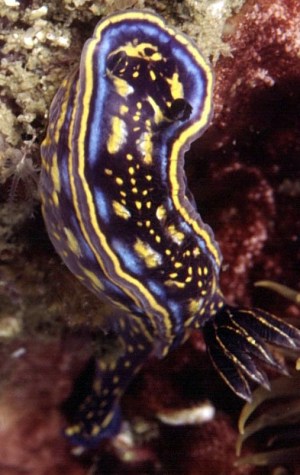
Hypselodoris malacitana
Luque, 1986
Order: NUDIBRANCHIA
Suborder: DORIDINA
Superfamily: EUDORIDOIDEA
Family: Chromodorididae
DISTRIBUTION
Known only from the Mediterranan coast of Spain
PHOTO
Punta del Vapor, Almuñecar, Granada Coast, Spain. size 40mm; depth 7 m; April 1999. Photo: Luis Sánchez Tocino
Reference:
• Ortea, J., Valdés, A. & García-Gómez, J.C. (1996) Revisión de las especies atlánticas de la familia Chromodorididae (Mollusca: Nudibranchia) de grupo cromático azul. [Review of the Atlantic species of the family Chromodorididae (Mollusca: Nudibranchia) of the blue chromatic group.] Avicennia, 1996, Suppl. 1: 1-165.
Rudman, W.B., 2001 (October 28) Hypselodoris malacitana Luque, 1986 . [In] Sea Slug Forum. Australian Museum, Sydney. Available from http://www.seaslugforum.net/find/hypsmala
Related messages
Re: Hypselodoris bilineata? from Senegal
June 9, 2006
From: Andrej Jaklin
Concerning message #16619:
Dear Marina and Bill,
My humble opinion is that this is H. malacitana, rather than H. bilineata. One character I newer saw on H. bilineata are such a numerous fine yellow specks all over the body, including the tail.
At the same time, reading some old messages regarding those two species, I would say that in message #9683 is also H. malacitana.
Best wishes,
aj
jaklin@cim.irb.hr
Jaklin, A., 2006 (Jun 9) Re: Hypselodoris bilineata? from Senegal. [Message in] Sea Slug Forum. Australian Museum, Sydney. Available from http://www.seaslugforum.net/find/16819Dear Andrej,
There is no need to feel humble - all views are welcome. From the work of Ortea et al (1996) I would agree that Marina's animals in message #16619 seem to be H. malacitana. However the animals in her message #9683 look identical to the animals, also from Senegal, in Fig 6 F, G of Ortea et al, where they are are identified as H. bilineata.. There seem to be two differences. In the Senegalese version of H. bilineata, the central part of the mantle has whitish spots or lines arranged longitudinally and bordered by a yellow line. In Senegalese H. malacitana, the central part of the mantle has scattered yellow spots, sometimes with a median line of spots as well.
Marina appears to have provided us with an interesting selection of photos of 'blue chromdorids' from Senegal. I guess only further study will clarify whether we are dealing with a single variable species, or two different species which appear to be mimicking each other.
Again I must say I have no personal experience with these species so I am guided solely by the published literature and photos on the Forum. I would appreciate further input
- Ortea, J., Valdés, A. & García-Gómez, J.C. (1996) Revisión de las especies atlánticas de la familia Chromodorididae (Mollusca: Nudibranchia) de grupo cromático azul. [Review of the Atlantic species of the family Chromodorididae (Mollusca: Nudibranchia) of the blue chromatic group.] Avicennia, 1996, Suppl. 1: 1-165.
Best wishes,
Bill Rudman
Re: Hypselodoris bilineata? from Senegal
June 9, 2006
From: Marina P. Ossokine
Concerning message #16619:
Dear Bill,
Thank you for your identification of Hypselodoris malacitana from Dakar. I didn't thought about this species because originally it was considered as restricted to the Mediterranean, but I agree that externally Senegalese animals fit this species quite well. Hypselodoris malacitana always troubled me because externally it is almost identical to Atlantic Hypselodoris cantabrica. Are they really different? Unfortunately I don't have Ortea et al (1996) paper to see better the differences.
Best wishes,
Marina.
nembro@nembro.info
Poddubetskaia Ossokine, M., 2006 (Jun 9) Re: Hypselodoris bilineata? from Senegal. [Message in] Sea Slug Forum. Australian Museum, Sydney. Available from http://www.seaslugforum.net/find/16826Dear Marina,
I totally agree with your doubts about H. cantabrica and H. malacitana which I have discussed in an earlier message [#14740]. Clearly there is more work to be done with this group. I don't suppose you would have any photos of the egg ribbons of Seneglaese animals. It would be nice to compare them with your photos of H. cantabrica [#12746 ].
Best wishes,
Bill Rudman
Hypselodoris bilineata? from Senegal
June 2, 2006
From: V. Caro & M. Ossokine
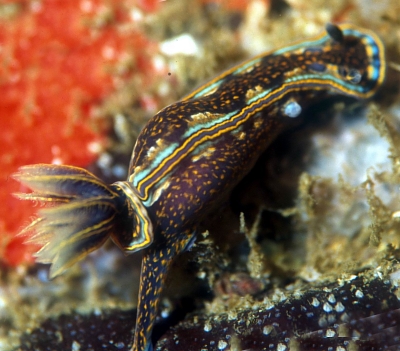
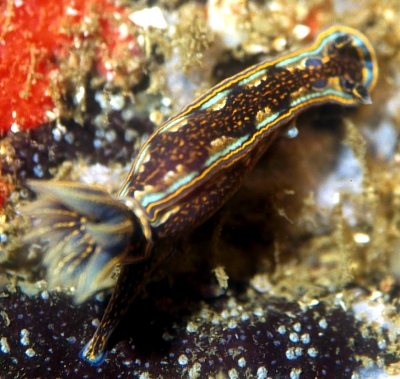
Dear Bill,
Valerie Caro sent me these Hypselodoris photos from Senegal for identification. These animals surprised me and I think it is interesting enough to be shared with the Forum. So, Valerie agreed I write you in her name.
At first sight this animal looks similar to several Caribbean species. But it doesn't fit any species I know. In fact, I think it is a colour form of Hypselodoris bilineata, because it has many characters common with this species, even if it seems different at first sight :
- gills : 2 lines externally and one line internally
- rhinophores : yellow line posteriorly
- dorsal pattern : same sequence of yellow, black and bright blue lines or bands
Locality: 'Grand Turiba', Dakar, 30m, Senegal, Atlantic Ocean, 20 February 2004. Length: 3-4 cm. Photographer: Valerie Caro.
Bill, could you give us your opinion on these animals, please.
Thank you in advance for your valuable help.
Best wishes,
Marina (and Valerie).
[Marina Poddubetskaia Ossokine & Valerie Caro]
valanafred@free.fr
nembro@nembro.info
Caro, V. & Poddubetskaia Ossokine, M., 2006 (Jun 2) Hypselodoris bilineata? from Senegal. [Message in] Sea Slug Forum. Australian Museum, Sydney. Available from http://www.seaslugforum.net/find/16619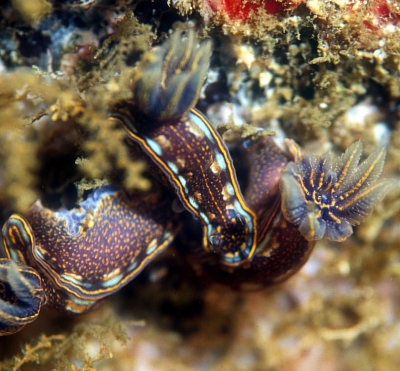
Dear Valerie & Marina,
I agree these are very interesting animals. I think they also illustrate that we still have a lot to learn about the Atlantic 'blue chromodorids'. They certainly have similarities in colour to H. bilineata, but the distinctive feature in that species seems to be the median double yellow line on the dorsum. Edmunds (1982) identifies animals from Ghana, with white lines inside the yellow lines as H. bilineata, and Ortea et al (1996) do the same with animals from Senegal. In the animals in your message there are no median yellow lines, although there is a single median row of yellow dots in one animal. Instead the prominent feature are the fine yellow dots scattered all over the central part of the mantle and the sides of the body.
I don't know if you have a copy of Ortea et al (1996), but although I am puzzled by some of the decisions in that revision, it is the best summary available. In that they have a photo (Fig 7E) of a juvenile of H. malacitana which has the same basic colour pattern as your animals, although the spots are a little larger.
I am posting a number of messages today on 'blue chromodorids'. I hope some local experts can give us their opinions.
- Edmunds, M. (1981) Opisthobranchiate Mollusca from Ghana: Chromodorididae. Zoological Journal of the Linnean Society, 72(2): 175-201.
- Ortea, J., Valdés, A. & García-Gómez, J.C. (1996) Revisión de las especies atlánticas de la familia Chromodorididae (Mollusca: Nudibranchia) de grupo cromático azul. [Review of the Atlantic species of the family Chromodorididae (Mollusca: Nudibranchia) of the blue chromatic group.] Avicennia, 1996, Suppl. 1: 1-165.
Best wishes,
Bill Rudman
Hypselodoris malacitana? from Portugal
September 8, 2005
From: David Abecasis
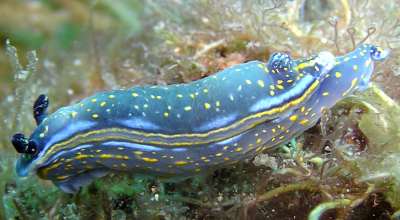
I wonder if you can give me a hand identifying these sea slugs.
Locality: Faro, Portugal. Depth: 15 m. 06 May 2005. Photographer: David Abecasis
David Abecasis
davidbecas@netcabo.pt
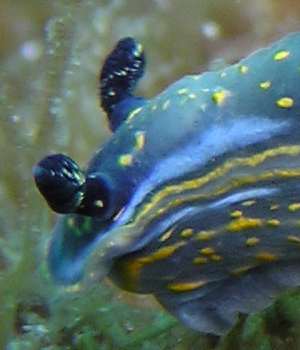
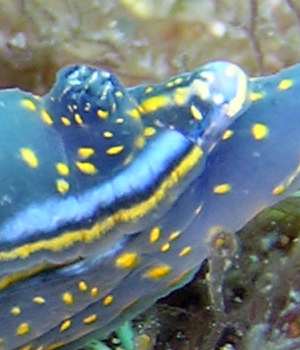
Dear David,
I think this is Hypselodoris malacitana, but I am having some difficulty deciding the difference between this species and H. cantabrica. Both species seem quite variable in colour and both have colour forms with a median yellow line on the dorsum. Ortea, Valdés, García-Gómez (1996) mention that one of the distinguishing features of H. malacitana is a yellowish line down the posterior midline of the rhinophore which splits basally to form an inverted V. Looking at the photos of H. cantabrica on the Forum [messages #2124, #12745] they also have this same marking. If they are both H. malacitana as well, I have no idea how the two species can be differentiated. Any advice would be welcome.
-
Ortea, J., Valdés, Á. & García-Gómez, J.C. (1996) Revisión de las especies atlánticas de la familia Chromodorididae (Mollusca: Nudibranchia) de grupo cromático azul. [Review of the Atlantic species of the family Chromodorididae (Mollusca: Nudibranchia) of the blue chromatic group.] Avicennia. Revista de Ecologia y Oceanologia y Biodiversidad Tropical. Supplement 1. 165pp.
Best wishes,
Bill Rudman
Hypselodoris malacitana? from Canary Ids
November 21, 2002
From: Isabel Creo
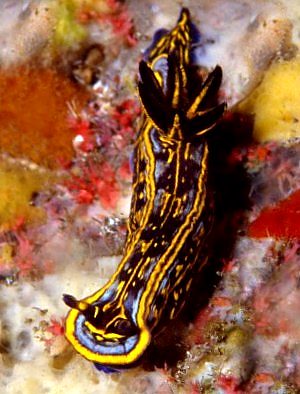
Dear Bill:
I'd like you to help me with the identification of this nudibranch from El Hierro Island, which is the smallest of the Canary Ids and located in the extreme southwest of the chain.
At first sight it seems to be Hypselodoris picta, but its rhinophores don't have the uniform blue that was to be expected. Another strange thing is the number and shape of gills. The photos were taken in El Hierro this year, and there were three more identical specimens in the area.
Thanks in advance.
Isabel Creo
icreo@soluziona.com
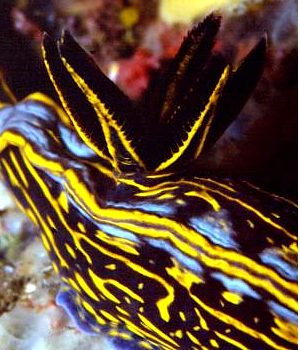
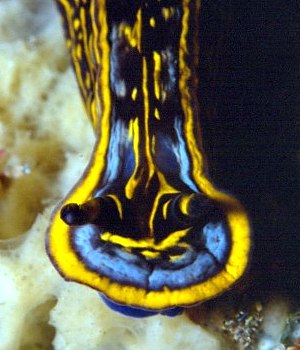
Dear Isabel,
These 'blue chromodorids' are indeed easy to misidentify, so like you I hesitate to sound to confident. However I am pretty sure this is Hypselodoris malacitana. The yellow mantle border with a thin dark blue line on the inner and outer edge seems quite characteristic, as does the lighter blue submarginal band. If it is H. malacitana it is an interesting find, for as far as can can determine this species has previously only been recorded from the Spanish coast of the western Mediterranean.
Best wishes,
Bill Rudman
Hypselodoris malacitana from the Mediterranean
October 30, 2001
From: Luis Sánchez Tocino
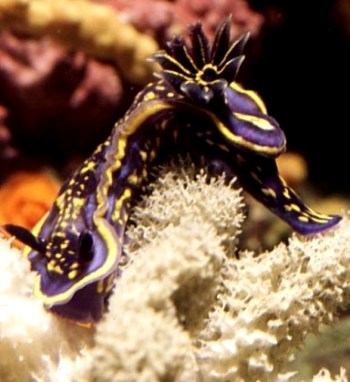
Dear Dr. Rudman
Here are some photos of Hypselodoris malacitana Luque, 1986 from Almuñecar, Granada Coast, Spain.
UPPER RIGHT: Piedra del Hombre (Bahía de la Herradura), on food sponge Ircinia cf. fasciculata. size 35 mm; depth 8m; November 1999
LOWER LEFT: Cantarriján Beach. size 35 mm; depth 8 m; November 1999
LOWER RIGHT: Punta del Vapor. size 40 mm; depth 7 m; April 1999
Luis
lstocino@ugr.es
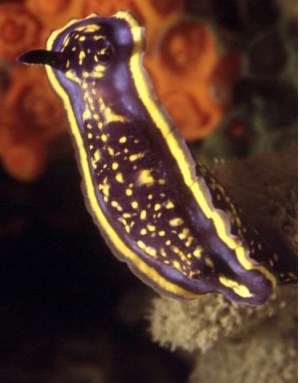

Thanks Luis,
I can't find any reference to its food in Ortea, Valdes & Garcia-Gomez (1996). In the upper photo it is on a sponge you identify as a species of Ircinia. Do you know if that is its preferred food sponge?
Best wishes,
Bill Rudman
